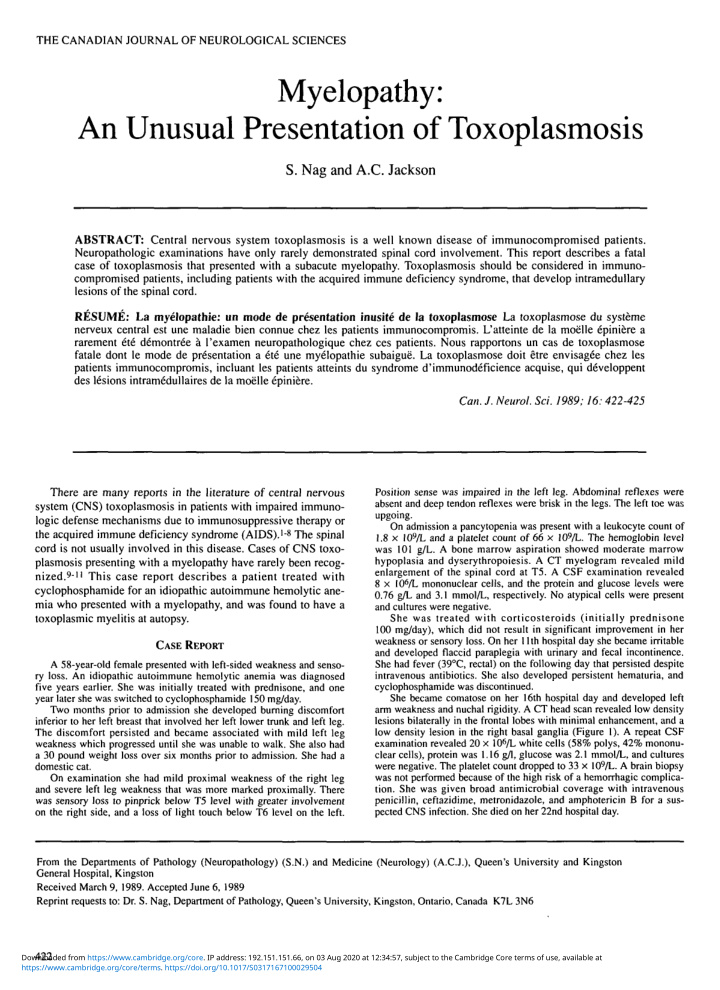



THE CANADIAN JOURNAL OF NEUROLOGICAL SCIENCES Myelopathy: An Unusual Presentation of Toxoplasmosis S. Nag and A.C. Jackson ABSTRACT: Central nervous system toxoplasmosis is a well known disease of immunocompromised patients. Neuropathologic examinations have only rarely demonstrated spinal cord involvement. This report describes a fatal case of toxoplasmosis that presented with a subacute myelopathy. Toxoplasmosis should be considered in immuno- compromised patients, including patients with the acquired immune deficiency syndrome, that develop intramedullary lesions of the spinal cord. RESUME: La myelopathic: un mode de presentation inusite de la toxoplasmose La toxoplasmose du systeme nerveux central est une maladie bien connue chez les patients immunocompromis. L'atteinte de la moelle epiniere a rarement ete demontree a l'examen neuropathologique chez ces patients. Nous rapportons un cas de toxoplasmose fatale dont le mode de presentation a ete une myelopathic subaigue. La toxoplasmose doit etre envisaged chez les patients immunocompromis, incluant les patients atteints du syndrome d'immunodeficience acquise, qui deVeloppent des lesions intramedullaires de la moelle epiniere. Can. J. Neurol. Sci. 1989; 16: 422-425 Position sense was impaired in the left leg. Abdominal reflexes were There are many reports in the literature of central nervous absent and deep tendon reflexes were brisk in the legs. The left toe was system (CNS) toxoplasmosis in patients with impaired immuno- upgoing. logic defense mechanisms due to immunosuppressive therapy or On admission a pancytopenia was present with a leukocyte count of the acquired immune deficiency syndrome (AIDS). 1 " 8 The spinal 1.8 x 10 9 /L and a platelet count of 66 x 10 9 /L. The hemoglobin level cord is not usually involved in this disease. Cases of CNS toxo- was 101 g/L. A bone marrow aspiration showed moderate marrow hypoplasia and dyserythropoiesis. A CT myelogram revealed mild plasmosis presenting with a myelopathy have rarely been recog- enlargement of the spinal cord at T5. A CSF examination revealed nized. 9 " 11 This case report describes a patient treated with 8 x 10 6 /L mononuclear cells, and the protein and glucose levels were cyclophosphamide for an idiopathic autoimmune hemolytic ane- 0.76 g/L and 3.1 mmol/L, respectively. No atypical cells were present mia who presented with a myelopathy, and was found to have a and cultures were negative. toxoplasmic myelitis at autopsy. She was treated with corticosteroids (initially prednisone 100 mg/day), which did not result in significant improvement in her weakness or sensory loss. On her 11th hospital day she became irritable CASE REPORT and developed flaccid paraplegia with urinary and fecal incontinence. She had fever (39°C, rectal) on the following day that persisted despite A 58-year-old female presented with left-sided weakness and senso- intravenous antibiotics. She also developed persistent hematuria, and ry loss. An idiopathic autoimmune hemolytic anemia was diagnosed cyclophosphamide was discontinued. five years earlier. She was initially treated with prednisone, and one She became comatose on her 16th hospital day and developed left year later she was switched to cyclophosphamide 150 mg/day. Two months prior to admission she developed burning discomfort arm weakness and nuchal rigidity. A CT head scan revealed low density inferior to her left breast that involved her left lower trunk and left leg. lesions bilaterally in the frontal lobes with minimal enhancement, and a The discomfort persisted and became associated with mild left leg low density lesion in the right basal ganglia (Figure 1). A repeat CSF examination revealed 20 x 10 6 /L white cells (58% polys, 42% mononu- weakness which progressed until she was unable to walk. She also had a 30 pound weight loss over six months prior to admission. She had a clear cells), protein was 1.16 g/1, glucose was 2.1 mmol/L, and cultures were negative. The platelet count dropped to 33 x 10 9 /L. A brain biopsy domestic cat. was not performed because of the high risk of a hemorrhagic complica- On examination she had mild proximal weakness of the right leg tion. She was given broad antimicrobial coverage with intravenous and severe left leg weakness that was more marked proximally. There was sensory loss to pinprick below T5 level with greater involvement penicillin, ceftazidime, metronidazole, and amphotericin B for a sus- on the right side, and a loss of light touch below T6 level on the left. pected CNS infection. She died on her 22nd hospital day. From the Departments of Pathology (Neuropathology) (S.N.) and Medicine (Neurology) (A.C.J.), Queen's University and Kingston General Hospital, Kingston Received March 9, 1989. Accepted June 6, 1989 Reprint requests to: Dr. S. Nag, Department of Pathology, Queen's University, Kingston, Ontario, Canada K7L 3N6 Downloaded from https://www.cambridge.org/core. IP address: 192.151.151.66, on 03 Aug 2020 at 12:34:57, subject to the Cambridge Core terms of use, available at 422 https://www.cambridge.org/core/terms. https://doi.org/10.1017/S0317167100029504
Recommend
More recommend